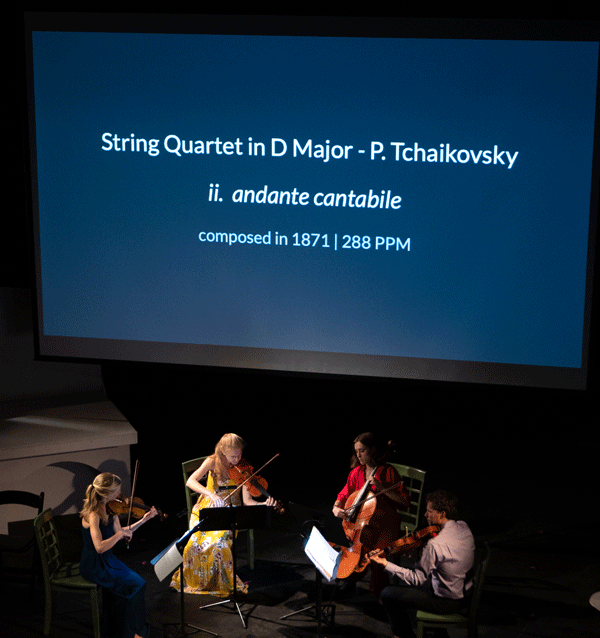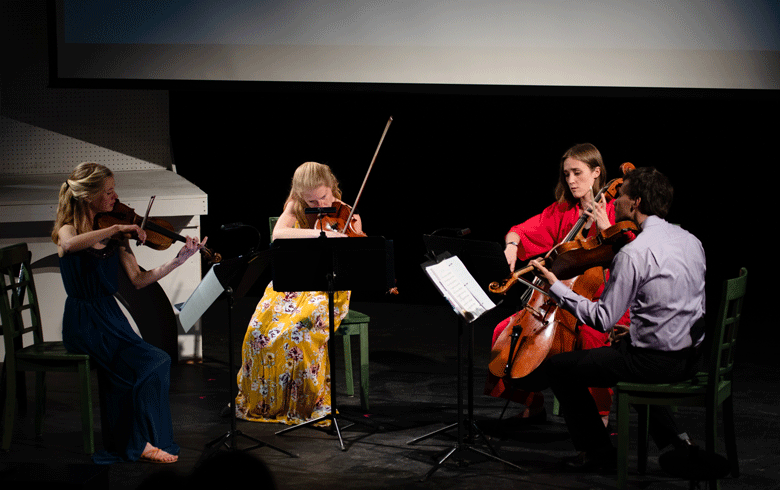The seven North Haven students in combined grades 4, 5, and 6 carried in cushions and arranged them on the floor while older students doubled up on sofas at the back of the high-ceilinged study area. On the walls hung a painting of a lobster boat and the articulated skeleton of a white beaked dolphin. Strains of violins, cello, and viola floated down corridors as Midcoast Maine’s Halcyon Quartet tuned up to play for Maine’s smallest K-12 public school.
Projected onto the slanted ceiling above the musicians was a satellite view of home—downtown North Haven and its working waterfront. But along the shorefront, a wash of lurid green overlay familiar places—the ferry terminal, Brown’s Boatyard, the Casino, Hopkins Wharf, and seafront houses. Above that, a darker shade of green lapped across Main Street.
Sophie Davis, lead violinist and artistic manager of Halcyon, scribbled projected sea-levels on a whiteboard—dividing students into groups to prepare for rises of 1, 4, and 9 feet—that will mark their future
“Even if we do everything we can to limit sea level rise, it’s going to affect our way of life.”
—Sophie Davis
“The 4-foot, sea level rise by 2100 is the most likely scenario for us in Maine,” Davis explained. “A worst-case scenario is 9 feet. Even if we do everything we can to limit sea level rise to 1 foot, it’s going to affect our way of life.”
If students looked at a projected 4-foot sea level rise for the entire island, they’d see they will eventually “need a bridge to get to Iron Point,” on the eastern tip of the island, Davis said.
Pollution, warming temperatures, and melting glaciers are to blame, but once set in motion, sea level rise accelerates from thermal expansion—water molecules expanding as sea temperatures rise, Davis explained. The Gulf of Maine is warming faster than 90% of of the world’s seas and oceans. North Haven, Rockland, and all the Penobscot Bay islands are particularly at risk.
“Our living and our culture is defined by the ocean, by fishing, aquaculture and recreation,” she said.

“It’s heavy, a lot to think about,” said Sophie’s sister Josie Davis, also a violinist. The Davis sisters and cellist Nora Willauer grew up in Waldoboro and Union, playing music together since the age of five. Willauer’s grandfather helped found Outward Bound on nearby Hurricane Island. Viola player Colin Wheatley, who grew up in Seattle, is director of the orchestra for Waterville schools. Behind a projector sat video artist and violinist Luke Fatora, from Colorado, who had bicycled around Vinalhaven and Rockland in December, taking drone footage of winter high tides.
“As young people we spend a lot of time thinking about [climate change], how to be involved. How to make the scenarios most scary not happen—to protect those places we don’t want to be underwater,” Josie Davis said.
But what difference can a small group of young classical musicians make? This is the challenge Halcyon Quartet set for itself in designing its concert “Rise Up!” which it premiered at Waterman’s Community Center on May 13 before playing for audiences in Rockland and Vinalhaven.
“What we hope to do is to create something that grapples with complex information and hopefully makes you feel something, maybe different than you did before,” Sophie Davis said. “So much music is inspired by the environment and conveying a landscape.”
Her commitment to making a difference dates back to Oberlin Conservatory where she took on an unusual double major in music and environmental studies. She then won a Fulbright grant to study the interplay of art and politics on the Pacific island of Samoa
At a performance at the island’s Waterman’s Community Center, the quartet’s program included selections from Bach, traditional Danish tunes, Tchaikovsky, Phillip Glass, and ending with Pete Seeger’s “Tomorrow is a Highway.” In the light booth, Fatora wove in video footage of king tides washing over the Rockland Breakwater, cars and trucks splashing across flooded roads on Vinalhaven, and high seas washing up against the North Haven waterfront.
Title slides for each piece included the composer, date of composition, and atmospheric CO2 concentrations—doubling from the crisp, pure oxygenated 277 parts per million in Bach’s time to 404 ppm in 2017. Another fact, which hit close to home, was that with 4 feet of sea level rise, Waterman’s will be flooded at each high tide.
At the concert’s heart was Samuel Barber’s deeply emotional Adagio for Strings, composed in 1935 with CO2 levels at 305 ppm, set to imagery showing the present waterfronts of North Haven and Vinalhaven slowly sinking beneath NOAA’s medium and high sea level rise projections. The audience watched as water overtook over docks and shorefront until Brown’s, Hopkins Wharf, and Waterman were only rooftops poking above the sea.
“It was sad,” said Pat Curtis, 86, who has lived on North Haven all but two years of her life. “Sad and very powerful.”
At North Haven Community School, students were busy with action plans. Proposals for combatting and managing sea level rise included putting up signs to note where high tides would reach, building seawalls, relocating wharfs, raising roads, and damming the Thorofare and using tidal power for energy.
“Sometimes Brown’s Boatyard is already underwater,” 4th-grader Odin observed, suggesting that more people might take to houseboats. There are already two houseboats moored in Pulpit Harbor.
“What about seaweed and oysters, clams?” asked 10th-grader Bryn, whose family owns the North Haven Oyster Company. “Growing all this stuff takes CO2 out of the air with carbon sequestration.”
The students gave enthusiastic thumbs-up to the effectiveness of Halcyon’s project.
“The music touches a different part of your brain,” said 11th-grader Sophie.
“Not a lot of people see it,” Bryn said. “This makes it clear what it’s going to look like.”
“The music they played made you feel everything was serious and you needed to do something about it,” agreed 9th-grader Ezra.
Heading off to tend to the school’s organic garden, 4th-grader Sig summed up the concert most succinctly.
“It was lovely and absolutely terrifying. Lovely because of the music and terrifying because my family’s business will be underwater and my grandmother’s house will be underwater.”





